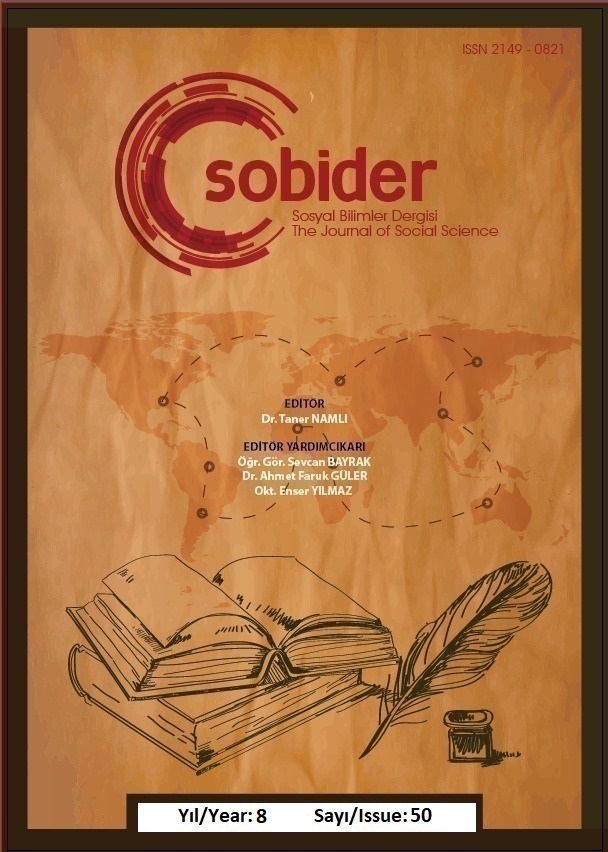Author :
Abstract
Tarih boyunca farklı dinleri benimseyen Türkler, bu dinlerin öğretilerini yayma amacıyla birçok eser ortaya koymuşlardır. Aynı şekilde İslamı seçtikleri ilk zamanlardan itibaren Kur'an'ı Türkçeye çevirerek bu dini öğrenmeye ve öğretmeye çalışmışlardır. Eski Anadolu Türkçesi döneminde de bu durum devam etmiştir. Yapılan tercümelerin dönemin dil özelliklerini yansıtmasının yanında çeviride kullanılan tamlamalar da Türkçenin zenginliğini ortaya çıkarmaktadır. Bu çalışmada tamlamanın geleneksel gramerde nasıl ele alındığı, hangi noktaların muğlak kaldığı ve nasıl izah edilmesi gerektiği tartışıldıktan sonra asıl unsur ve yardımcı unsur ilişkisine bağlı olarak telaffuz edilmeyen tamlanan durumu açıklanacaktır. Daha sonra eserdeki Allah vasıflarına ait tamlananı telaffuz edilmeyen örnekler ortaya konulup incelenecektir.
Keywords
Abstract
Turks, who have adopted different religions throughout history, have produced many works in order to spread the teachings of these religions. In the same way, from the first time they chose Islam, they tried to learn and teach this religion by translating the Qur'an into Turkish. This situation continued during the Old Anatolian Turkish period. In addition to the fact that the translations reflect the language characteristics of the period, the phrases used in translation also reveal the richness of the Turkish language. In this study, after discussing how phrases are handled in traditional grammar, which points remain ambiguous and how they should be explained, depending on the relationship between the main element and the auxiliary element, the unspoken complemented condition will be explained. Later, examples of the qualities of Allah, which are not its pronounced complemented in the work, will be put forward and examined.
Keywords
- Aydın, Hasene (2012), “Dilde Sıfır Birim ve Sıfır Biçimbirimin Kullanımı”, Turkish Studies- International Periodical For The Languages, Literature and History of Turkish or Turkic Volume 7/2 Spring 2012, p.169-181, Ankara
- Banguoğlu, Tahsin (1995), Türkçenin Grameri, Türk Dil Kurumu Yayınları, Ankara
- Bilgegil, M.Kaya (2014), Türkçe Dilbilgisi, Salkımsöğüt Yayınları, Erzurum
- Ergin, Muharrem (2013), Türk Dil Bilgisi, Bayrak Basım/Yayım/Tanıtım, İstanbul
- Delice, H. İbrahim (2018), Türkçenin Sözdizimi, Asitan Kitap, İstanbul
- Demirci, Kerim (2014), Türkoloji İçin Dilbilim Konular Kavramlar Teoriler, Anı Yayınları, Ankara
- Deny, Jean (2012), Türk Dil Bilgisi, Kabalcı Yayınevi, İstanbul
- Gemalmaz, Efrasiyap (1996), (STT’nde işaretsiz (/.Ø./) “Görev Ögeleri Üzerine”, Atatürk Üniversitesi Türkiyat Araştırmaları Enstitüsü Dergisi, S 6, s. 1-4. Erzurum
- Karaağaç, Günay (2013), Dil Bilimi Terimleri Sözlüğü, Türk Dil Kurumu, Ankara
- Karahan, Leyla (2008), Türkçede Söz Dizimi, Akçağ Yayınları, Ankara
- Korkmaz, Zeynep (1992), Gramer Terimleri Sözlüğü, Türk Dil Kurumu Yayınları, Ankara
- Küçük, Murat (2014), Eski Anadolu Türkçesi Dönemine Ait Satır Arası İlk Kur’an Tercümesi, TDK, Ankara
- Özmen, Mehmet (1996), “Bir Eksiltili Cümle Tipi Üzerine”, Çukurova Üniversitesi, Sosyal Bilimler Enstitü Dergisi, C. 4, S. 4, s. 71-82, Adana
- Türkçe Sözlük. (2011), Türk Dil Kurumu Yayınları, Ankara
- Turan, Zikri (2008), “Gösterme Sıfat Fiili” Ahmet Bican Ercilasun Armağanı, Akçağ Yayınları, 235-243. Ankara.
- Turan, Zikri (2018), “Türk Dilinin Eklerini Sınıflandırmanın Esasları”, Türkbilig, 2018/35: 97- 110.
- Üstünova, Kerime (2014), Türkiye Türkçesinde Yapı Kavramı ve Söz Dizimi İncelemeleri, Sentez Yayıncılık, Bursa





